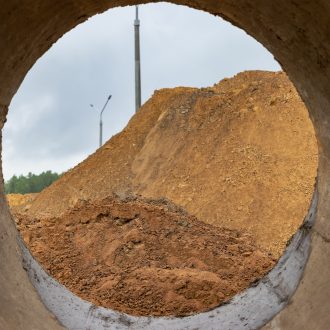
The construction industry is continuing to grow in the United States. Dodge Construction Outlook, reports that total U.S. construction starts for 2017 will advance 5% to $713 billion. The growth means our communities will continue to thrive and the need for diverting water will increase. Stormwater runoff takes over sewers and damages nearby streams and rivers through erosion and pollution. A way to handle the stormwater is to build a basin is meant to collect water and release it at a rate that prevents damage to our environment.
You might be familiar with detention and retention ponds. You know the ones you see around a new community of apartments or near a construction site. These ponds are meant to hold a set amount of water for a period of time depending on the type of pond. They exist to control potential flooding from stormwater runoff and help improve the overall water quality that leads into streams. So what is the difference between retention and detention ponds and when will we see each one?
1. Wet versus Dry
The biggest difference between detention and retention ponds is how long they hold water. A dry pond or detention pond only holds water for a short amount of time. Detention ponds are designed for a variety of reasons. They use a slight slope to divert water. For example, they are used for construction sites that have a slope or an emergency spillway in the event of a flood. Retention ponds do exactly what they say, they retain water temporarily or permanently. The level of water fluctuates depending on the amount of precipitation and runoff from surrounding areas.
2. Detention Ponds are more common in the West
In areas that are really dry, when it does rain, detention ponds give a place for snow to melt or stormwater to collect. Urban areas depend on this kind of pond to reduce peak rain and snow seasons. They vary in size depending on the function to settle stormwater particles and reduce peak flows.
3. Different kinds of basins
In a retention pond, it has an orifice, or riser, level with the bottom of the basin, which allows all of the water to eventually drain out after a storm. A retention basin has a riser at a higher point, so it retains a permanent pool of water. The basin slows and stores runoff from surfaces like rooftops and pavements which helps reduce the number of pollutants that goes into our natural sources of water like streams and lakes. If an orifice becomes clogged due to erosion or built up sediment, it needs to be repaired right away so that flooding does not occur especially if the this happens in a dry pond since the orifice is located low in the basin.
4. Both types assist with flood management
If pollutants enter streams or lakes during storms, ponds interrupt the transport process. Detention ponds usually hold storm water long enough to settle sands and larger silt particles. Fine silts and clays will not have a chance to settle and will continue down the water course. Retention ponds hold stormwater for longer periods of time and allow even the fine sediments to settle to the bottom of the pond.
Overall, both detention and retention ponds need to be maintained on a regular basis. Clogged orifices and other poor maintenance can lead to pesky pests, unpleasant odors, algae blooms, and just a bad looking pond.
Contact KCI for any questions about keeping up with your retention and detention pond.


